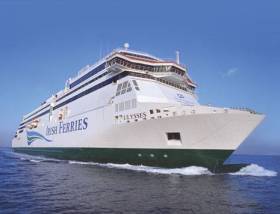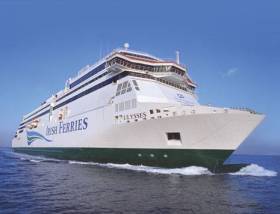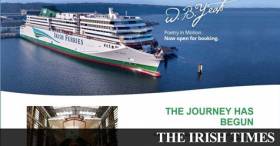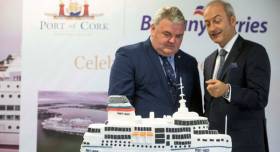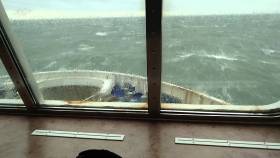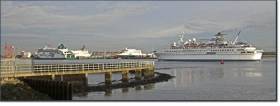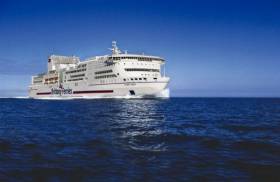Displaying items by tag: Cancelled Sailings
#FerryNews - Hundreds of holidaymakers who were forced to rearrange their travel plans after Irish Ferries cancelled all sailings of the WB Yeats to France this summer have now been told that their rescheduled crossings have also been cancelled.
As The Irish Times reports, the ferry company has transferred around 80 bookings with the ill-fated WB Yeats onto Epsilon but its scheduled crossing from Ireland to France this weekend has now been cancelled so it can ferry passengers on the Dublin-Holyhead route.
Irish Continental Group, which owns Irish Ferries, confirmed on Monday that repairs on its Ulysses vessel were more serious than originally anticipated and it will be out of service for up to two weeks.
For more on the ferry disruption during the peak-holiday season, click here.
#FerryNews - Operator Irish Ferries has said all sailings on the Ulysses vessel which serves the Dublin to Holyhead route have been cancelled for the next week.
As the The Irish Times reports, the ferry operator said the ship has been taken out of service due to a “technical issue” and to allow repairs be completed.
A spokeswoman for Irish Ferries said there is a problem with a propeller shaft necessitating the ship going to dry dock for a number of days and it is expected the Ulysses will return to normal service by the middle of next week.
In a statement (for updates click here) the company said all passengers affected are currently being advised and will be accommodated on an alternative ship or sailing.
For more on this story, click here.
Afloat adds the flagship departed Dublin Port this evening and is bound for Harland & Wolff, Belfast to undergo repairs.
Ferry Operator ‘Irish Ferries Understands it has Been Frustrating’ – the Understatement of the Week
#FerryNews -Irish Ferries last September announced that work had started in a German shipyard on a €144 million ship that would be the pride of its fleet. It said that, in accordance with tradition, a specially commissioned ceremonial coin would be placed in the keel during construction to “bring good luck and calm seas for the vessel”.
As The Irish Times writes, the coin has not done its job.
The “WB Yeats”– as the new boat was named following a public competition that attracted tens of thousands of submissions – has been dogged by bad luck, and its failure to arrive in Ireland on schedule ahead of a busy season of summer crossings has done untold damage to the reputation of Irish Ferries and left the holiday plans of tens of thousands of Irish passengers all at sea.
News that things were going awry with the luxury ferry – which has space for 1,885 passengers and crew, 440 cabins including suites with private balconies, and 3km of car deck space – first reached The Irish Times on April 20th. “There are rumours that Irish Ferries new €144m ship, which is scheduled to take passengers from Dublin to Cherbourg from July, is delayed by a few weeks,” a mail from a reader and would-be passenger started.
“The rumour is they are going to take the existing bookings and tell everyone they are going to be accommodated on the boat from Rosslare instead,” it continued.
To read more on the story click here.
#FerryNews - The National Transport Authority (NTA) which regulates sea travel to and from Ireland has said it is examining whether thousands of passengers impacted by Irish Ferries cancelling its summer sailings on the WB Yeats are entitled to compensation.
As The Irish Times writes, the NTA said it was “extremely disappointed” by the cancellations which will see all crossings from July 30th to September 17th scrapped .
All told approximately 19,000 passengers in addition to 10,000 passengers already affected by a previous wave of cancellations in April have had holiday planes thrown into disarray.
An NTA spokesman said those affected were entitled to full refund or an alternative sailing “at the earliest opportunity, under comparable conditions and at no additional cost”.
He said they may also “be entitled to claim compensation depending on length of delay in arrival at [THE]final destination and depending on the cause of that delay”.
The NTA is the national enforcement body for maritime passenger rights under EU Regulations and the spokesman told The Irish Times that it was “considering in light of this development how [EU RULES ]will apply to ensure that passengers impacted by this announcement receive the protections provided for”.
Passengers have expressed anger at frustration at the difficulties they have encountered in trying to make contact with the company since the cancellations were announced.
To read more on a flood of calls from customers, click here.
#FerryNews - Trying to help people is Britanny Ferries with those who booked with Irish Ferries WB Yeats, but may not be able to accommodate many because they are nearly full for July and August.
As the Irish Examiner writes, Brittany Ferries chief executive Christophe Mathieu said some people who had booked trips to France with Irish Ferries had rebooked with his company for the Cork-Roscoff route, but space is now nearly at a premium.
Around 19,000 people have had their summer sailings to France cancelled due to a delay in the delivery of a new ferry to Irish Ferries.
Mr Mathieu made the comments yesterday at a special reception in Ringaskiddy, Co Cork, which marked 40 years since Brittany Ferries opened its Cork-Roscoff service.
“Brittany Ferries was only five years old when we launched services linking Roscoff and Cork back in 1978. In our first year of operations we carried just under 22,000 passengers on the MV Armorique,” said Mr Mathieu.
The newspaper had more here on the new Ireland-Spain service and the impact of Brexit.
Cancelled Ireland-France Sailings This Weekend As Storm Brian Takes Hold Also On Irish Sea
#ferrydisruption - Today's Brittany Ferries sailing from Cork to Roscoff is among routes that have seen crossings cancelled due to the adverse weather conditions arising from Storm Brian.
The company is currently contacting all passengers to offer assistance due to the cancelled scheduled sailing this afternoon.
Last night's inward bound sailing to Cork from France had too been cancelled. As a result cruiseferry Pont-Aven was forced to vacate the single berth at the Breton port. This was to faciliate another Brittany Ferries cruiseferry, Armorique that too has had to cancel sailings today to Plymouth in the UK.
The cancellation of Pont-Aven's round trip Irish route this weekend has led to cruiseferry having to take shelter further along the coast in the Baie de St. Brieuc.
For latest sailing updates on Cork-Roscoff route, click Brittany Ferries website here to include contact details (by scrolling down) beyond English Channel routes.
The seasonal operated Irish service ends this year with final sailings taking place from France on Friday, 3rd November and that from Ireland on Saturday, 4th November.
Other operators have also cancelled and delayed sailings between Ireland and the UK along with those serving between Ireland and France.
For the latest information from Irish Ferries click here for Stena Line, click this link and for those from P&O Ferries.
Further Disruption On Irish Sea As Ferries Ride Out Storm Doris Off Wexford Coast
#StormDoris – A pair of rival ferries have not been able to enter Rosslare Harbour from Wales since this morning due to Storm Doris. The gale to storm force conditions have battered coasts and caused high seas leading to ferry travel disruption throughout the Irish Sea.
For approximately the last seven hours, due to the adverse weather conditions both Irish Ferries and Stena Line ferries have been forced to ride out the storm off the Wexford coast. This has had a knock-on effect as subsequent scheduled sailings in the reverse direction to Wales this morning were cancelled.
Isle of Inishmore and Stena Europe were both due to dock at the Wexford port before 07.00hrs this morning, however the ferries headed as far as the South Arklow buoy. This passage away from Rosslare has been repeated several times by the ferries as they wait for conditions to moderate so to enable berthing at the Wexford ferryport.
The next scheduled sailing for Isle of Inishmore for 20.45 is on time from Rosslare to Pembroke. For the latest information from Irish Ferries routes, click here.
The next scheduled sailing of the Stena Europe at 21.15 is on time from Rosslare to Fishguard. To check the latest sailing updates from Stena Line services, click here.
Further north on the central corridor, Dublin-Holyhead sailings as previously reported were also caught up in the storm. Notably a Stena Line ferry from Holyhead, Stena Adventurer was also unable to enter the capital port due to high winds. Stena Adventurer finally docked at around 12.30.
The next sailing this afternoon of Stena Adventurer from Dublin to Holyhead has been cancelled.
According to the latest information correct at time of posting, Stena Line, (all vehicle passengers) were to be accommodated on Irish Ferries 14:15hrs Epsilon sailing.
As for (foot passengers) they are been accommodated on the 15:10hrs Stena Nordica. For more information contact ferrycheck on +353 (0) 1 907 5300.
For those travelling with P&O information on the Larne-Cairnryan by clicking here. And for Dublin-Liverpool follow this link.
A weather update from Met Eireann can be consulted here
Storm Doris Sweeps Across Irish Sea Leading to Ferry Travel Disruption
#StormDoris – Travel disruption due to Storm Doris has led to one of the largest ferries on the Irish Sea unable to enter Dublin Port due to the adverse weather conditions.
An attempt however by the 44,000 gross tonnage Stena Adventurer is now estimated to take place around 12.30 this afternoon. Other routes and ferry operators have also been affected with either cancelled sailings and delays arising from the fourth storm of this winter.
Stena Adventurer was scheduled to arrive in Dublin Port at 05.45hrs however high seas have led to a delay of six hours so far. The ferry which can accommodate 1,500 passengers had been circling Dublin Bay but later moved off Bray Head to wait for weather conditions to abate.
The corresponding return sailing of Stena Adventurer from Dublin of 08.20hrs this morning has been changed to 14.00hrs.
A fleetmate on the Ireland-Wales route, Stena Nordica had cancelled overnight sailings but is scheduled to take up the routine 15.10 sailing this afternoon to Holyhead.
Stena Nordica which used to serve the route had only entered service in recent days to cover the refit dry-docking of Stena Superfast X which is at Harland & Wolff, Belfast.
For the latest information on Stena Line sailing updates and from other routes click here
For Irish Ferries click this link. Noting certain Jonathan Swift fast-craft sailings and those by ropax Epsilon have been cancelled, though the larger flagship Ulysses remains operating as scheduled.
Those intending to travel on P&O’s North Channel route between Larne-Cairnryan click here. For the Dublin-Liverpool route click here.
Met Eireann earlier this morning issued a Marine Weather Warning of Status Orange. The Warning is for gale to storm force west or northwest winds continuing this morning on all coasts of Ireland and on the Irish Sea. For further weather updates click here
Storm Barbara Continues to Cause Ferry Cancellations
#Cancellations - Storm Barbara continues to cause ferry cancellations but also freight operations on the Irish Sea notably those serving Dublin Port in the busy run-up to the festive season.
Strong winds involving a ro-ro freight ferry arriving to Dublin this morning required tugs to assist while berthing at Terminal 5. A freight sailing tonight on a route to the UK has been cancelled.
The bad weather may pose a concern for passengers with possible further ferry cancellations closer to Christmas Eve in particular on the core Holyhead-Dublin services. Thousands of passengers make the trip annually from the UK to reach the capital and beyond. The route from Wales is operated by two operators, Irish Ferries and Stena Line.
At Dublin Port's main passenger ferry facility, Terminal 1 is where Irish Ferries fast-craft Jonathan Swift remains berthed in port due to cancellations as covered on Afloat yesterday. Sailings of the fast-craft's Dublin-Holyhead sailings today are cancellled due to the what the operator describes as 'adverse weather conditions'.
Irish Ferries advises that 'fast-craft' passengers will be accommodated on alternative sailings using the other Holyhead-Dublin cruiseferry Ulysses. Also currently operating on time is the ropax Epsilon.
Recently introduced by Irish Ferries is Oscar Wilde to boost capacity on the Dublin route which too however was affected by the bad weather. The cruiseferry’s morning sailing to Holyhead was cancelled and also this afternoon's sailing at 16.45hrs from the Welsh port to Dublin. Passengers are to be accommodated on tomorrow's 02.30hrs sailing, Saturday 24 December (Christmas Eve).
There have been no Stena Line cancellations reported so far today on their Holyhead-Dublin service which is operated by a pair of ferries. Stena have said that Storm Barbara is to bring wet and windy conditions to the UK and Ireland. The operator added that unfortunately this may cause disruption to some scheduled sailings today and Saturday (Christmas Eve).
It is advisable to check all ferry operator websites for the latest sailing information for times and (dates of operation given the festive season) and those on France-Ireland services.
#CancelledSailings - Plans of thousands of holidaymakers have been thrown into disarray after technical problems forced the cancellation of this weekend’s sailings of Brittany Ferries flagship Pont-Aven vessel between Cork and France.
The Irish Examiner writes that the French ferry and holiday company confirmed last night that the Pont-Aven’s scheduled sailing on Friday from Rosscoff to Cork, and its Saturday sailing from Cork to Rosscoff have both been cancelled.
They are among several Pont-Aven sailings between Ireland and England to France and Spain, which have been cancelled this week after the vessel developed propeller problems.
A Brittany Ferries spokesperson said: “Brittany Ferries is endeavouring to contact all affected passengers as soon as possible with advice and available options.
“Passengers are being asked to be patient as there may be difficulty in contacting Brittany Ferries due to the volume of calls.”
The spokesperson encouraged passengers to check the company website for sailing updates.
“The company apologises to all passengers for the inconvenience this will cause to journeys,” she said.
The Pont-Aven, Brittany Ferries’ flagship vessel, entered service in 2004.
The newspaper which mas more to report here also adds that plans announced two years ago to replace the vessel have been put on hold, it has emerged.




























